The world of tree mushrooms is a fascinating and diverse realm, with various species exhibiting unique characteristics and ecological roles. Though there are numerous tree mushrooms, we have highlighted 19 mushrooms that grow on trees below. From the culinary delights to the medicinal wonders, these mushrooms add intrigue and beauty to forests and woodlands worldwide. However, it is crucial to exercise caution and proper identification before consuming any wild mushrooms. With all wild mushrooms, following the guideline of proper identification is essential to avoid potential risks.
Additionally, while some mushrooms on this list are considered edible, it is important to note that individual reactions can vary, and some individuals may experience gastrointestinal distress after consumption. By understanding the types of trees they grow on, their common locations, and their growing seasons, we can appreciate the beauty and significance of these tree mushrooms while ensuring safety in our interactions with them.
Reishi (Ganoderma lingzhi)

A well-known mushroom is Reishi, which is also a medicinal mushroom that grows on trees.
©Photoongraphy/Shutterstock.com
The mushroom Reishi, also known as Lingzhi, is a medicinal mushroom that grows on trees. It grows on various hardwood trees, including oak, maple, and birch. This mushroom is widely distributed in temperate regions across the globe. Reishi mushrooms can be found throughout the year, although they are more prevalent in the autumn. They have a distinctive kidney-shaped cap with a shiny, reddish-brown surface and a woody texture. Traditional Chinese medicine highly reveres Reishi for its potential health benefits, including boosting the immune system and reducing inflammation. While not typically consumed for its culinary value due to its tough and bitter nature, people often prepare it as tea or in powdered form for medicinal purposes.
Turkey Tail (Trametes versicolor)

Turkey tail mushroom (Coriolus versicolor)
©Wirestock Creators/Shutterstock.com
You can find Turkey Tail mushrooms worldwide, growing on dead or decaying trees, mainly hardwoods such as oaks and beeches. Their name comes from the colorful concentric rings on their fan-shaped caps, resembling a turkey’s tail feathers. You can encounter these mushrooms in forests, woodlands, and even on tree stumps in urban areas. Turkey Tail mushrooms are a type of polypore known for their medicinal properties. People have studied them as they are rich in polysaccharides and have potentially immune-boosting effects. While not typically consumed for their culinary value due to their tough texture, they are sometimes used to make medicinal teas or extracts.
Lion’s Mane (Hericium erinaceus)
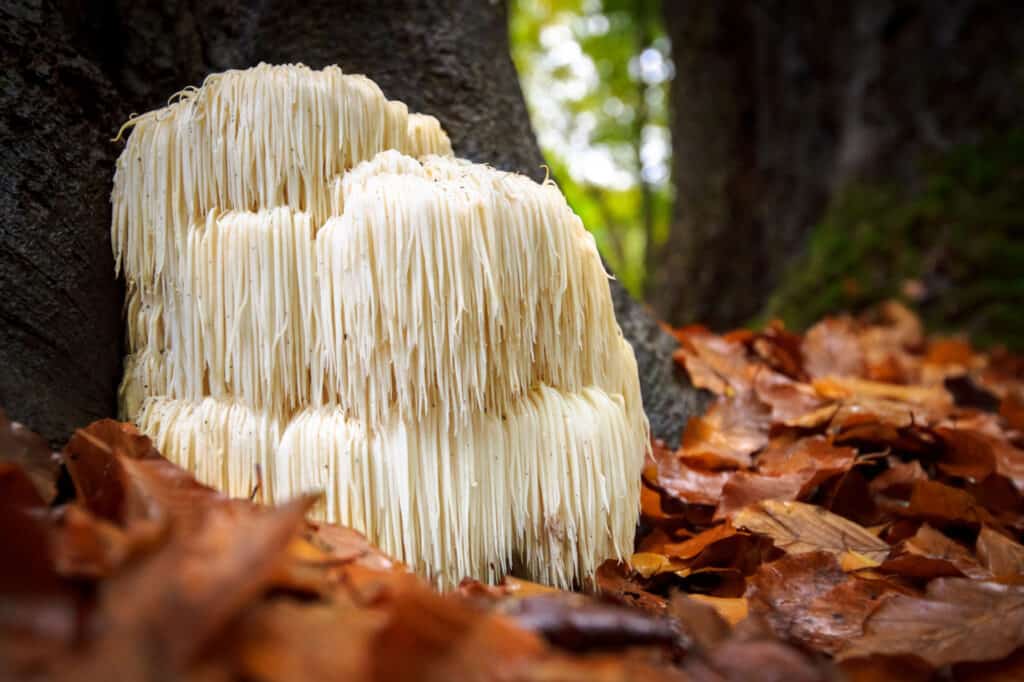
While they don’t look like traditional mushrooms, lion’s mane mushrooms are indeed edible.
©Fotografiecor.nl/Shutterstock.com
Lion’s Mane is a striking mushroom that grows on trees. It grows on various hardwood trees, including oak, beech, and maple. You can commonly find it in North America, Europe, and Asia. This mushroom gets its name from its appearance, resembling a lion’s mane with cascading white, icicle-like spines. Lion’s Mane is renowned for its culinary and potential medicinal benefits. It has a delicate seafood-like flavor and a texture reminiscent of crab or lobster meat when cooked. In addition to its culinary uses, Lion’s Mane has been studied for its potential cognitive benefits, such as improving memory and focus. It can be cultivated or foraged, and its popularity has led to its availability in specialty markets.
Chaga (Inonotus obliquus)
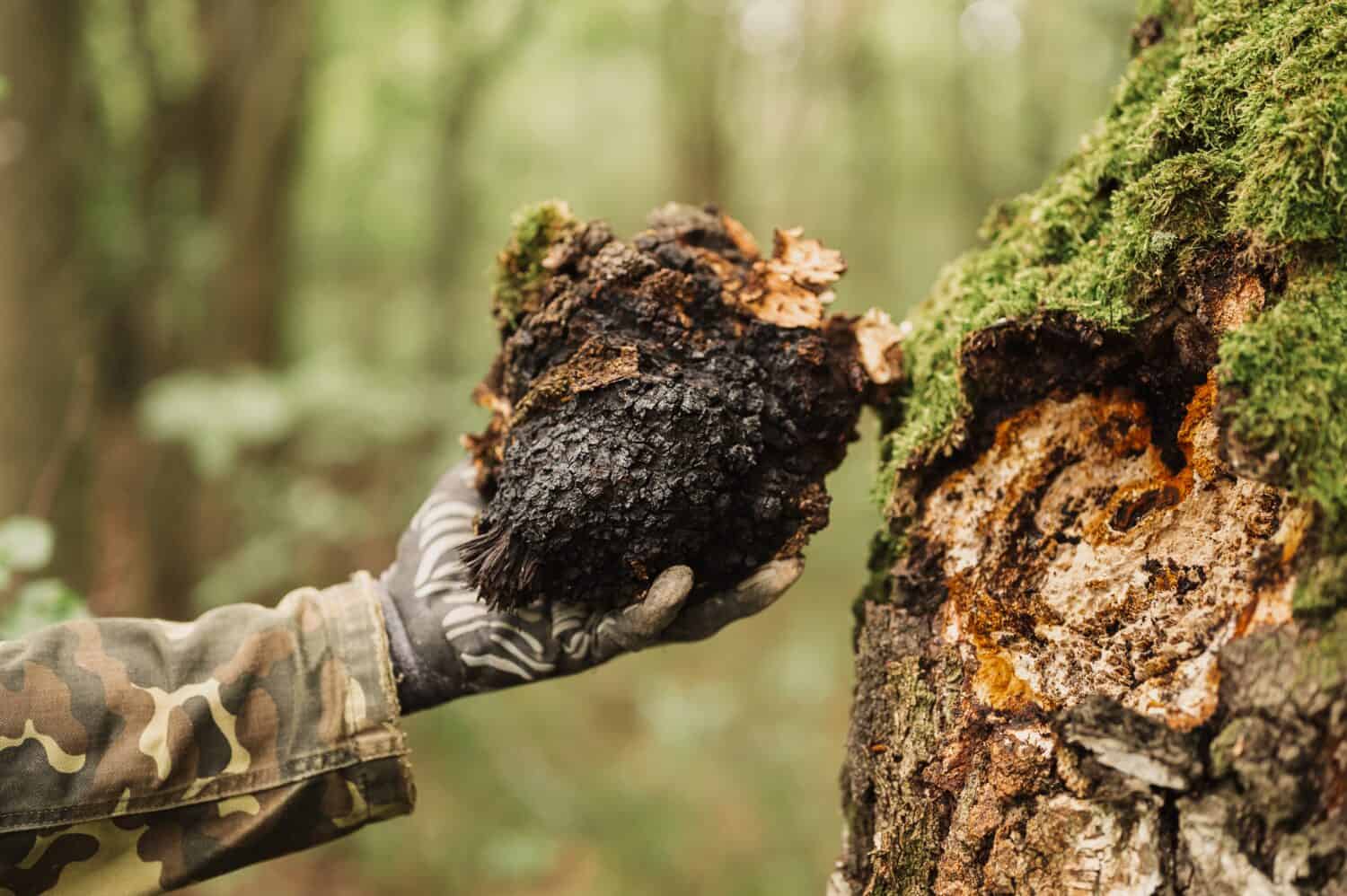
Chaga is black and appears to be a charcoal-like mass growing from tree bark.
©Ksenia Shestakova/Shutterstock.com
Chaga is a distinctive mushroom that grows on the trunks of birch trees, primarily in the northern regions of Europe, Asia, and North America. It appears as a black, charcoal-like mass protruding from the tree bark. People and traditional Chinese medicine highly value Chaga for its medicinal properties. It is rich in antioxidants and various bioactive compounds, believed to have immune-stimulating and anti-inflammatory effects. Chaga is usually harvested in winter when its concentration of bioactive compounds is highest. It is commonly prepared as a tea or used in extract form. Consuming this mushroom is uncommon, but it is used in tea and as a powder for potential health benefits.
Shiitake (Lentinula edodes)
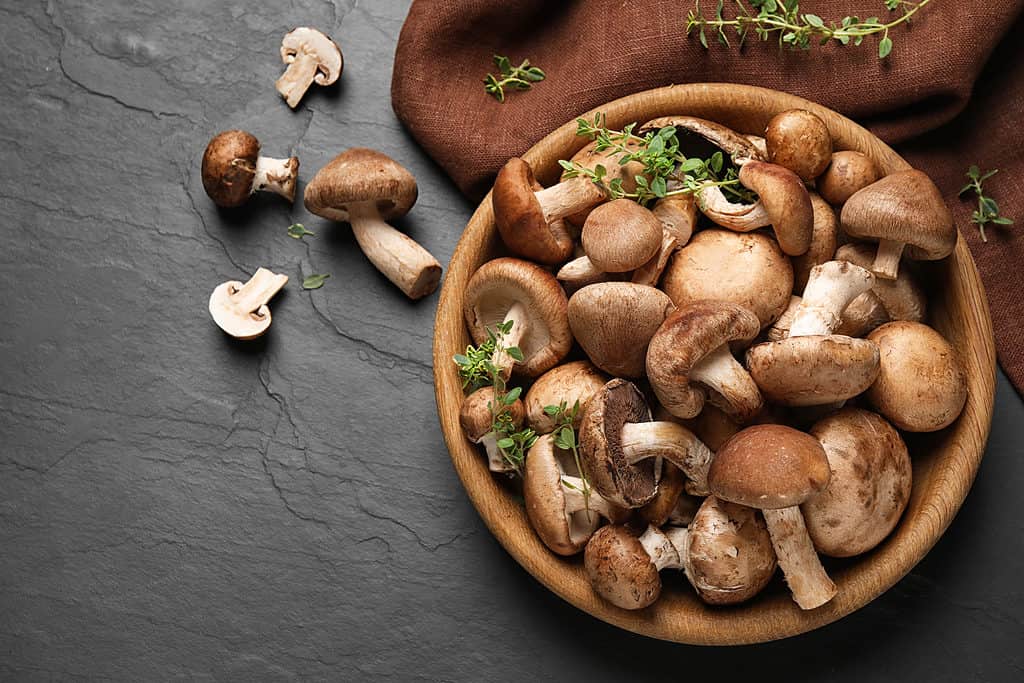
Shiitake mushrooms have a wonderfully meaty, chewy texture and complex, savory, nutty taste.
©New Africa/Shutterstock.com
Shiitake mushrooms are native to East Asia. However, you can find them worldwide as it is common amongst mushroom growers who cultivate them. They are primarily grown on decaying hardwood trees like oak, chestnut, and beech. Shiitake mushrooms have a broad, umbrella-shaped cap with a tan to dark brown color and a distinctive, savory flavor. They are highly prized in Asian cuisine and are known for their meaty texture and rich, earthy taste. Shiitake mushrooms are available year-round, and growers cultivate them indoors and outdoors. People have studied them because they are rich in nutrients and have immune-enhancing and cholesterol-lowering properties. Shiitake mushrooms can be used in various dishes such as stir-fries, soups, and sauces, making them a versatile and popular choice in many cuisines.
Oyster Mushroom (Pleurotus ostreatus)

©LeManilo/Shutterstock.com
The Oyster mushroom is a culinary delight known for its delicate flavor and velvety texture. You can find these mushrooms growing on the decaying wood of various hardwood trees, such as oak, beech, and birch. They are widespread, and you can find them in temperate regions around the world. People can cultivate Oyster mushrooms year-round. In the spring and fall seasons, they grow in abundance. They have a broad, fan-shaped cap with a smooth surface and gills running down the stem. The cap color varies from white to shades of gray, brown, or even blue. Cooking enthusiasts highly seek Oyster mushrooms for their culinary uses. They are popular in dishes like stir-fries, soups, and pasta sauces.
Tremella or Snow Fungus (Tremella fuciformis)
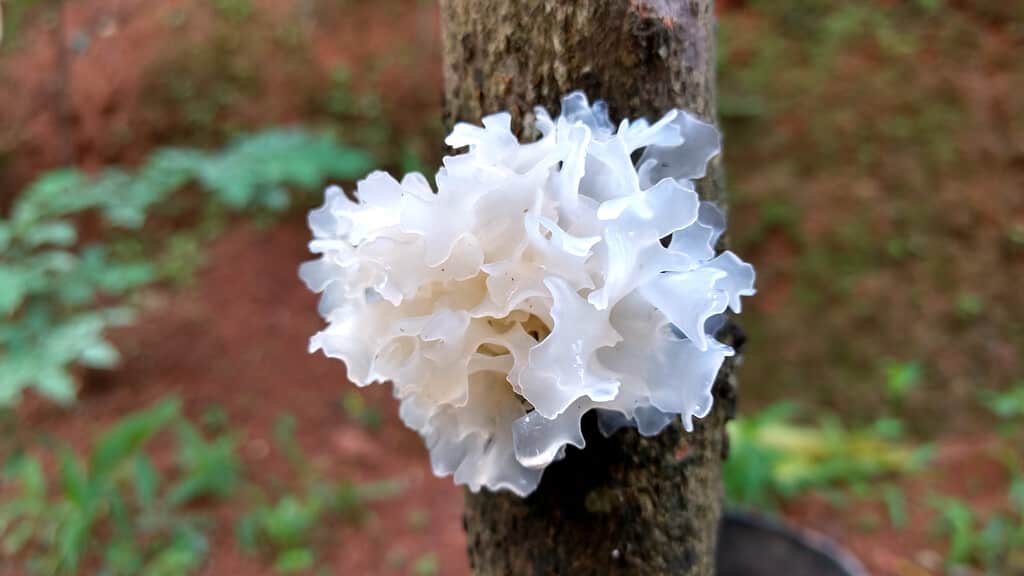
The beautiful and unique looking mushroom, Tremella fuciformis
©Ashish Sayani/Shutterstock.com
Tremella, also known as Snow Fungus, is a unique mushroom species that grows on dead or dying hardwood trees. You can commonly find it in tropical and subtropical regions, particularly Asia. Unlike most mushrooms, Tremella does not have a cap and stem structure. Instead, it appears as gelatinous, jelly-like white or yellowish-white masses resembling snow or brain-like formations. Tremella mushrooms are traditionally used in Chinese cuisine and desserts due to their gelatinous texture when cooked. Tremella mushrooms are rich in dietary fiber and offer various health benefits, including moisturizing and nourishing the skin. They are listed as safe to eat, but ensuring proper identification and cooking before consumption is essential.
Artist’s Conk (Ganoderma applanatum)
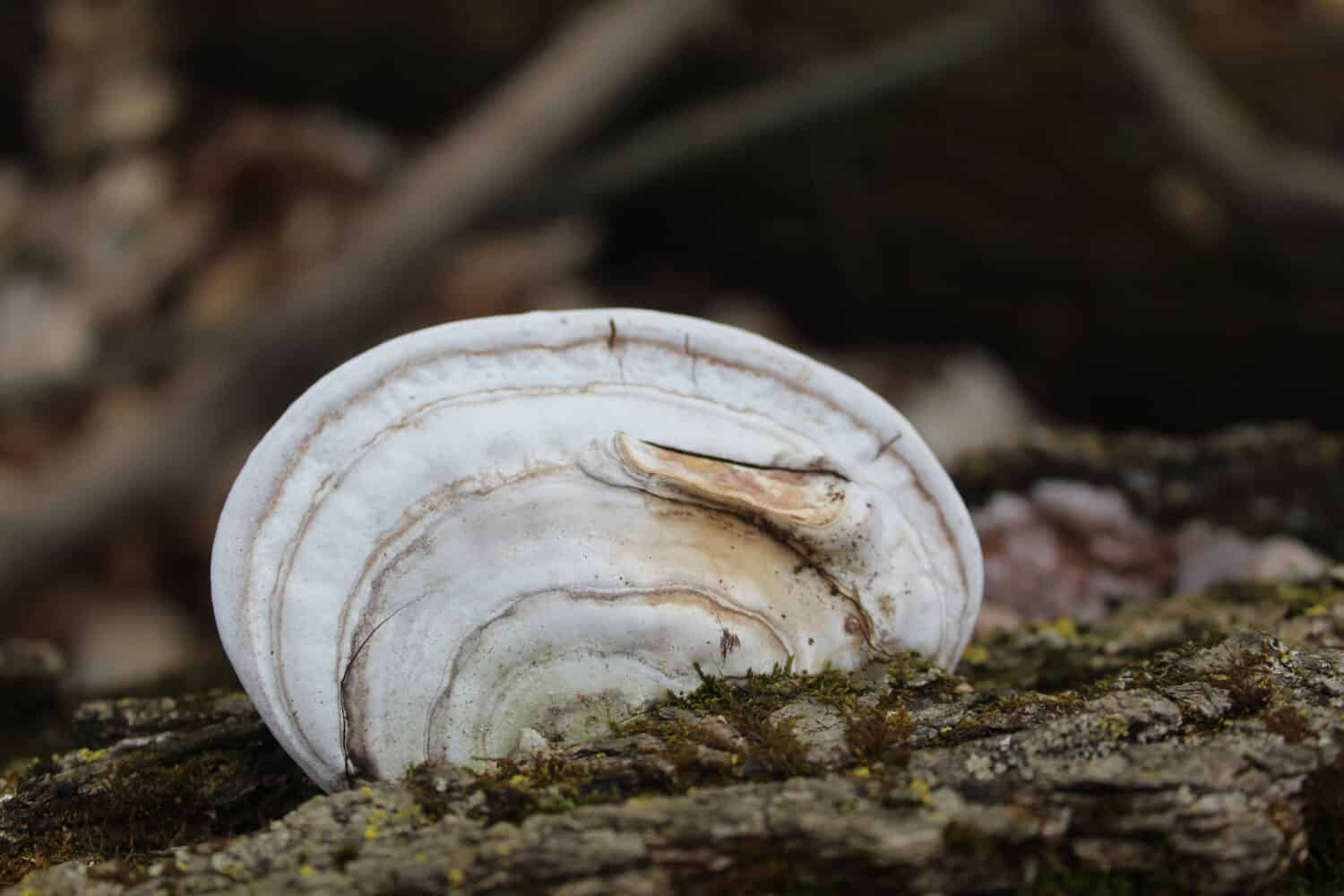
Artist’s Conk got its name from its capability to use its leathery surface for sketching or carving due to its ability to retain imprints.
©John Ruberry/Shutterstock.com
The Artist’s Conk is a large and conspicuous bracket fungus that grows on the wood of dead or dying trees, particularly hardwoods such as oak and beech. You can find it in North America, Europe, and other temperate regions. This mushroom is called Artist’s Conk because artists often use its leathery surface for sketching or carving due to its ability to retain imprints. The fruiting body of the Artist’s Conk is fan-shaped with a distinct white edge and a brown upper surface. It can persist for several years, slowly expanding in size. While not commonly consumed, this mushroom is not considered poisonous. However, its woody and tough texture makes it unappetizing for culinary use. Artist’s Conk is most notable for its artistic and ecological significance.
Birch Polypore (Piptoporus betulinus)
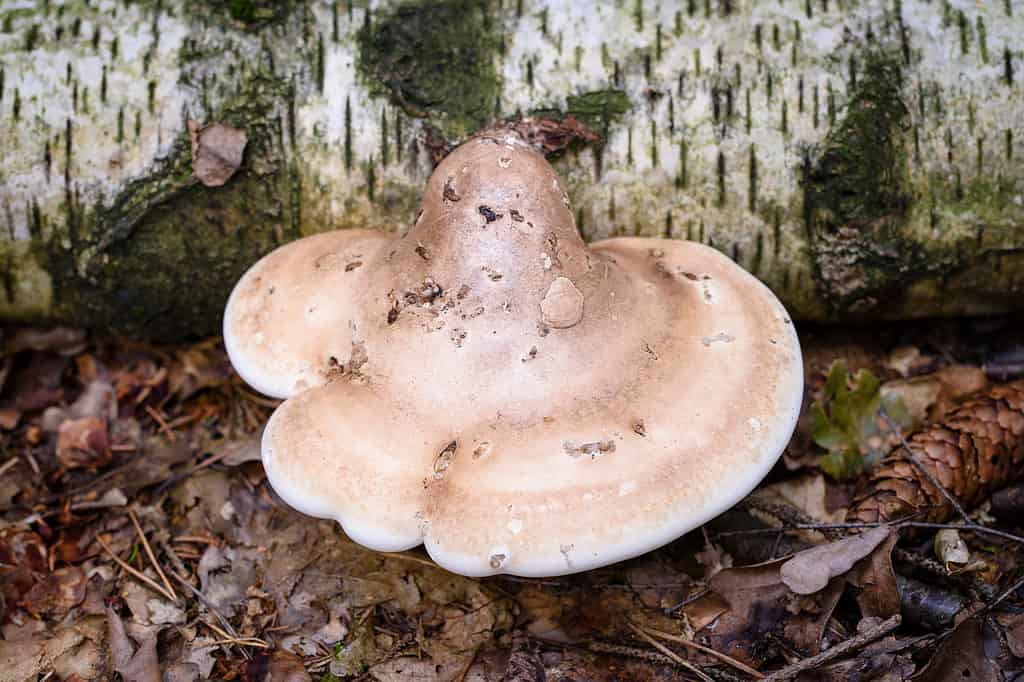
A birch polypore growing at the base of a tree
©Milan Vachal/Shutterstock.com
The Birch Polypore is a polypore mushroom that grows on trees. It exclusively grows on birch trees, particularly older or dying ones. You can find it in forests across Europe, North America, and Asia. This mushroom has a large, hoof-shaped or semicircular fruiting body with a light to dark brown upper surface and a white to yellowish lower surface filled with pores. The Birch Polypore has a long history of medicinal use and is known for its antiviral and immune-boosting properties. Traditionally, people used it as a natural tinder for starting fires, earning it the nickname Fire Tinder Fungus. While not commonly consumed as a culinary mushroom, people utilize it in medicinal teas or extracts.
Velvet Shank (Flammulina velutipes)
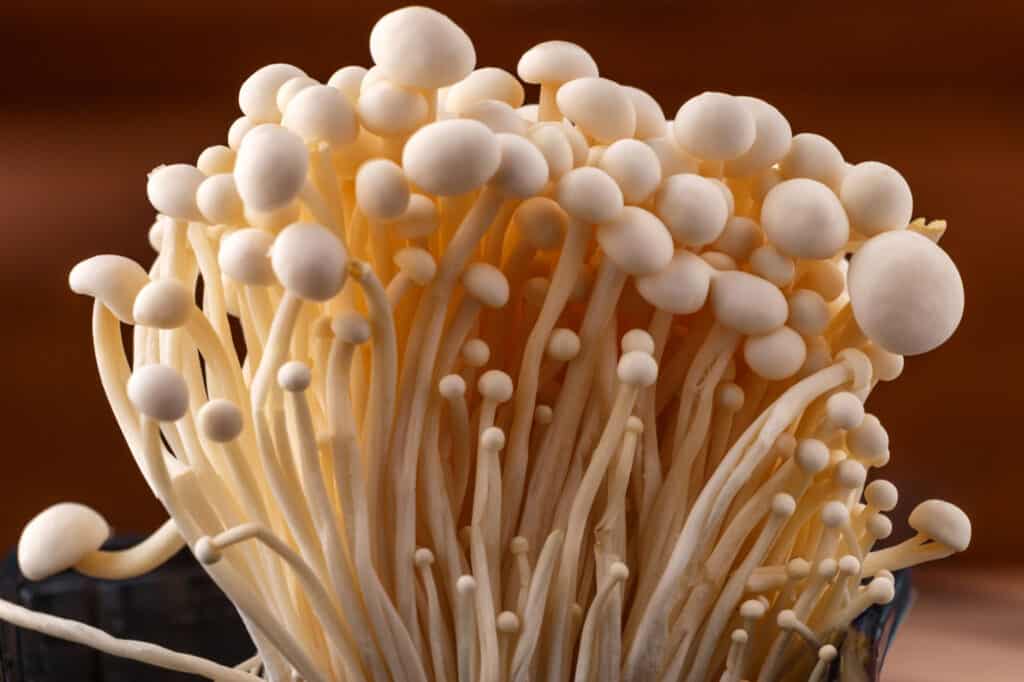
Edible and tiny, enoki mushrooms have a delightfully crisp texture.
©Tamakhin Mykhailo/Shutterstock.com
The Velvet Shank is a small to medium-sized mushroom that grows on decaying wood, particularly on the stumps and trunks of broadleaf trees, such as beech, oak, and elm. It is widespread, and you can find it in temperate regions around the world. This mushroom gets its name from its velvety, orange-brown cap and long, slender stem covered in fine hairs. It typically fruits during winter, making it a welcome sight in colder climates. The Velvet Shank is an edible mushroom valued for its crunchy texture and subtle earthy flavor. People use it in Asian cuisine, particularly in stir-fries and soups. Notably, the Velvet Shank can sometimes be confused with a poisonous look-alike called the Sulfur Tuft (Hypholoma fasciculare), so proper identification is crucial before consumption.
Birch Mazegill (Phellinus betulinus)
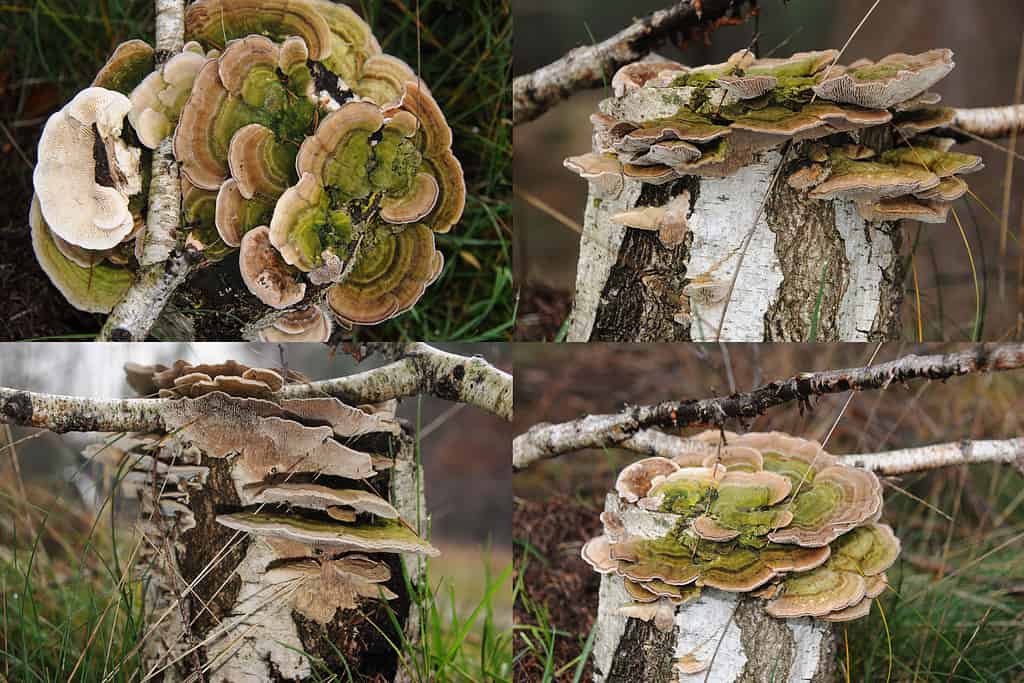
The Birch Mazegill is a polypore mushroom that exclusively grows on the trunks and branches of birch trees. You can find it in temperate regions across Europe, Asia, and North America. This mushroom forms large, semicircular brackets with a dark brown to black upper surface and a porous, cream-colored lower surface. Birch Mazegills are perennial mushrooms that you can find throughout the year. However, you can most commonly observe them in the summer and autumn. This fungus is known for its medicinal properties, and people have used it in traditional medicine for its potent antioxidant and antimicrobial effects. While not commonly consumed for culinary purposes as it is unappetizing, Birch Mazegills are not considered poisonous.
Chicken of the Woods (Laetiporus sulphureus)
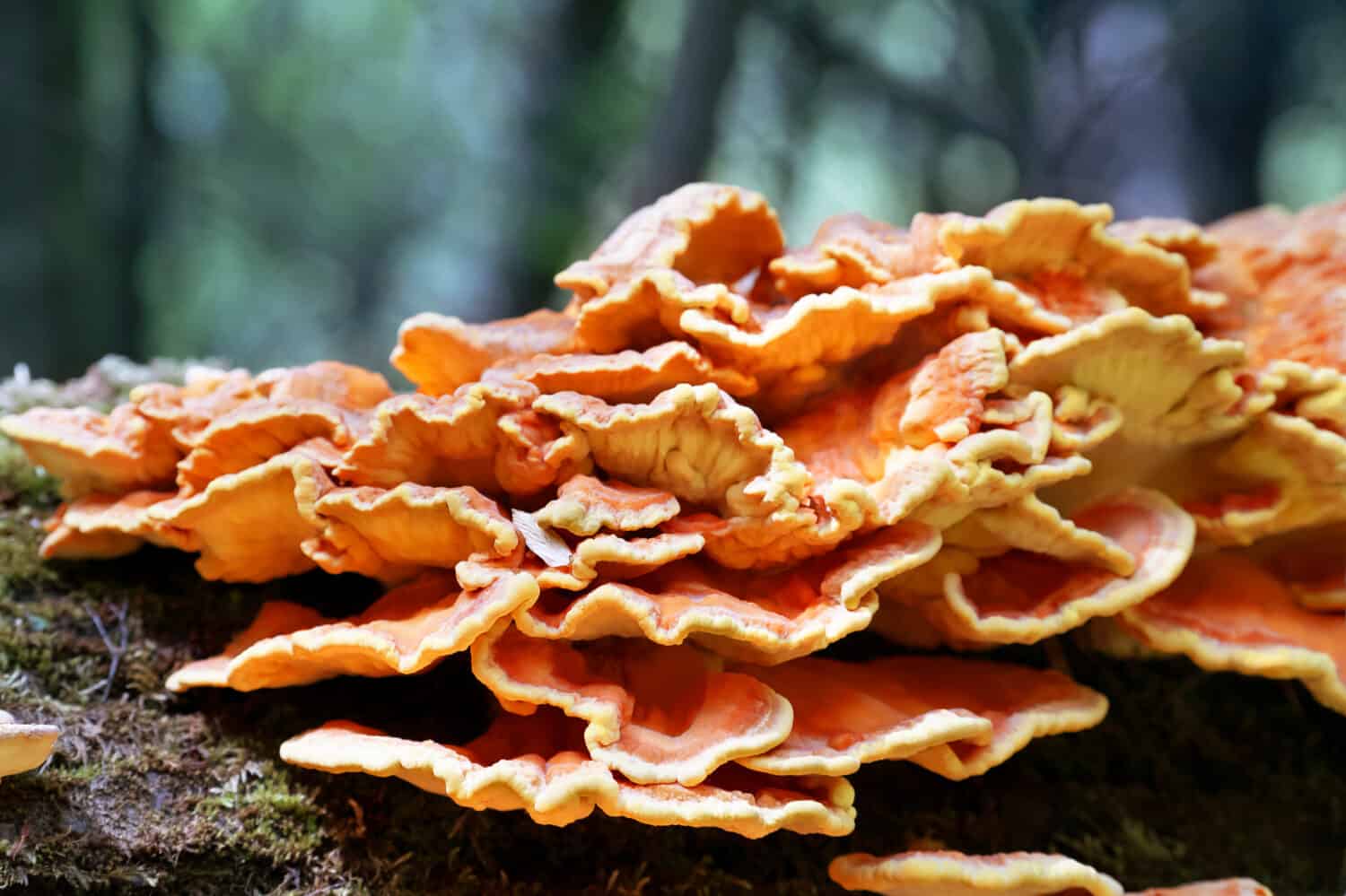
Chicken of the Woods is a popular culinary tree mushroom.
©Ksenia Lada/Shutterstock.com
The Chicken of the Woods, also known as Sulphur Shelf, is a bracket fungus that grows on living or dead trees, mainly hardwoods such as oak and chestnut. You can find it in North America, Europe, and Asia. This mushroom forms large, overlapping brackets with a bright orange to yellow upper surface and a smooth, cream-colored lower surface. The Chicken of the Woods typically fruits from spring to autumn. People highly regard it as a culinary mushroom, especially for its meaty texture and savory flavor reminiscent of chicken. It is popular in various dishes like stir-fries and soups.
Shaggy Mane (Coprinus comatus)
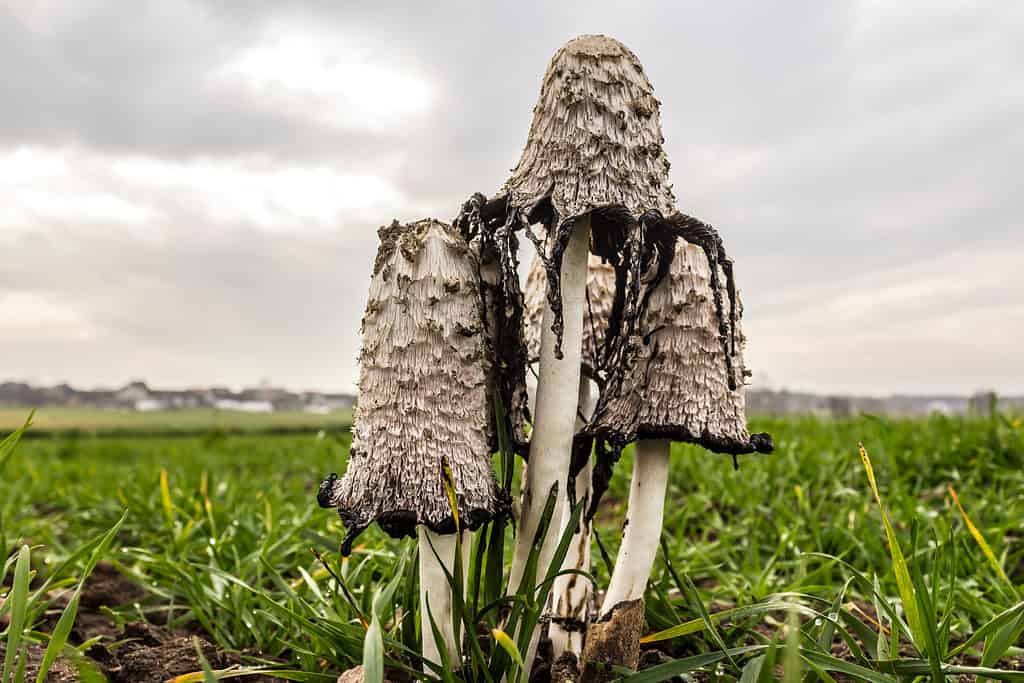
The shaggy mane mushroom growing in a field and release a black inky substance to release spores
©sheris9/Shutterstock.com
The Shaggy Mane is a fascinating mushroom that grows on trees. People know it for its distinctive appearance and behavior. It grows in grassy areas and open spaces, often near decaying wood or on lawns. You can find this mushroom in North America and Europe. The Shaggy Mane has a cylindrical, elongated cap covered in shaggy, white scales. The cap liquefies from the bottom as it matures, giving it an inky appearance. A process known as autodigestion. The Shaggy Mane usually appears from late spring to autumn. It is edible when young and fresh, with a delicate flavor. However, people must not consume it with alcohol as it may cause adverse effects. It also has a short shelf life and is best consumed soon after harvest.
Horn of Plenty (Craterellus cornucopioides)

black trumpet mushrooms growing in the wild
©SariMe/Shutterstock.com
The Horn of Plenty, also known as the Black Trumpet, is a trumpet-shaped mushroom that grows on the forest floor, particularly in association with coniferous and deciduous trees. You can find it in Europe, North America, and Asia. The Horn of Plenty has a funnel-shaped cap with wavy edges and a black-to-dark brown color. It typically appears in late summer to autumn. People have regarded this mushroom for its culinary value, offering a rich, earthy flavor that complements a variety of dishes. People often use it in sauces, soups, and as a seasoning.
Beechwood Sickener (Russula nobilis)

The Beechwood Sickener is a brightly colored mushroom. You can find it growing in association with beech trees in forests across Europe. It has a vibrant red-to-orange cap and white-to-cream-colored gills. This mushroom fruits during the summer and autumn seasons. The Beechwood Sickener is not edible. It contains a compound called russula toxin, which can cause severe gastrointestinal symptoms and poisoning when consumed. Therefore, it is essential to avoid consuming this mushroom. It is worth noting that some species within the Russula genus are edible and highly valued. However, proper identification is crucial to differentiate them from potentially toxic species.
Blushing Bracket (Daedaleopsis confragosa)
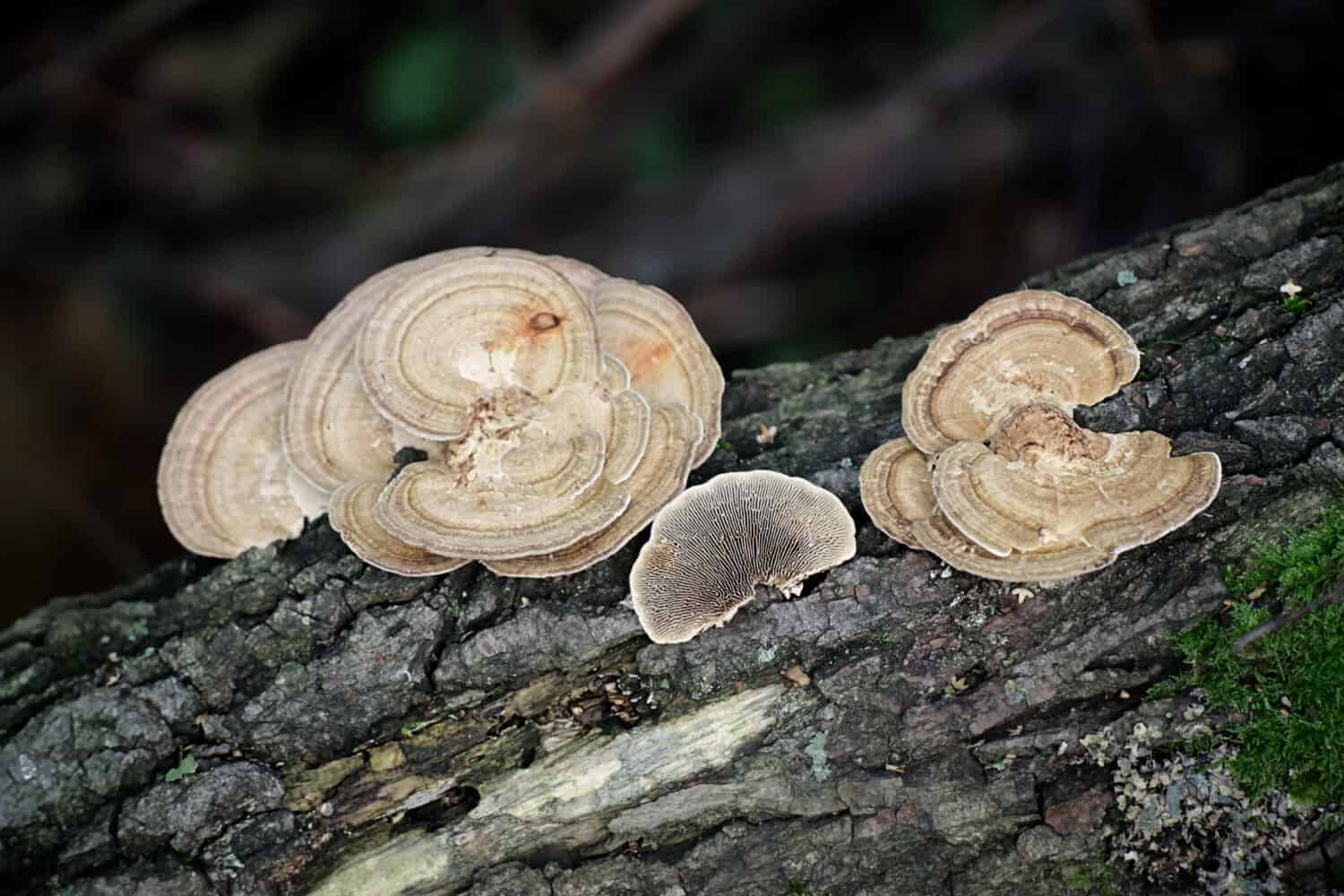
You can find Blushing Bracket in temperate forests of North America and Europe.
©Henri Koskinen/Shutterstock.com
The Blushing Bracket is a wood-rotting mushroom that grows on trees. It typically grows on the deadwood of hardwood trees. You can find it in temperate forests of North America and Europe. This mushroom has a shelf-like fruiting body with a grayish-brown upper surface that develops pinkish hues when touched or damaged. Its underside features white or yellowish pores. You can observe Blushing Brackets year-round, but they are more abundant during the summer and autumn. Although not poisonous, people do not normally consume them. Like all mushrooms, Blushing Brackets play a vital role in ecosystem processes as decomposers, breaking down dead wood and recycling nutrients back into the environment.
Oak Bracket (Inonotus dryadeus)
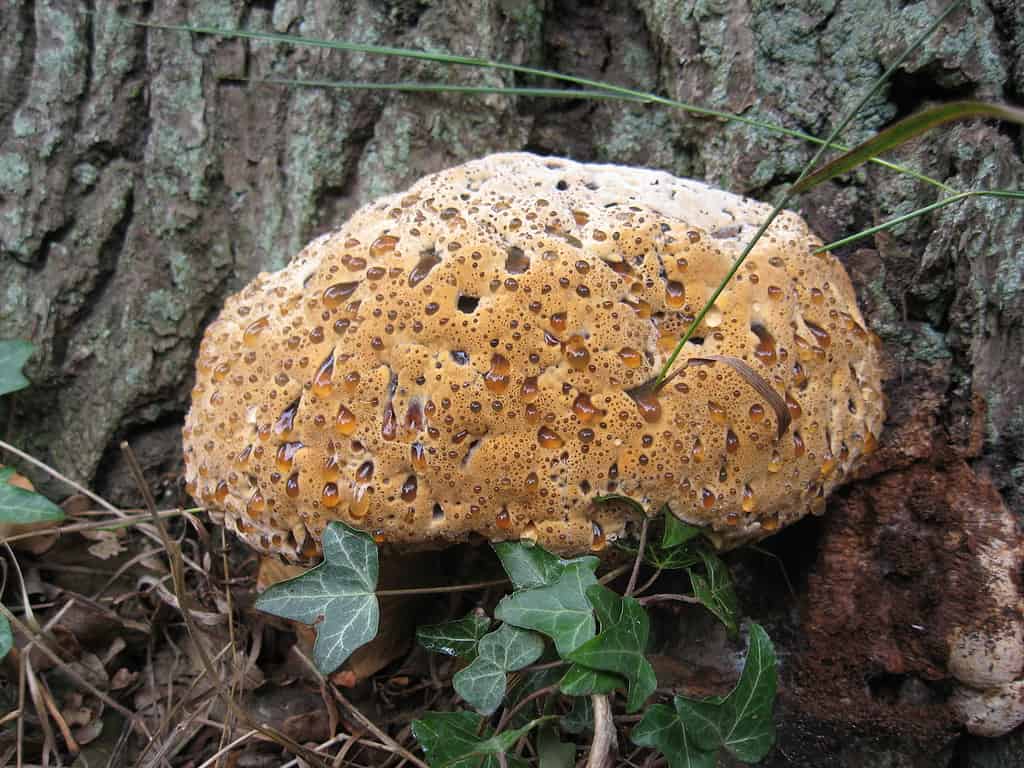
The Oak Bracket, also known as the Weeping Conk, is a large bracket fungus that primarily grows on the trunks and branches of oak trees. You can find it in Europe and North America. This mushroom forms large, semicircular brackets with a brown to reddish-brown upper surface and a porous, cream-colored underside. Oak Brackets typically appear in late summer and autumn. They are saprophytic, meaning they feed on decaying organic matter. Though non-poisonous, it is uncommon to consume them. The presence of Oak Brackets on oak trees can indicate a decline in tree health, as they often colonize stressed or weakened trees.
King Alfred’s Cakes (Daldinia concentric)
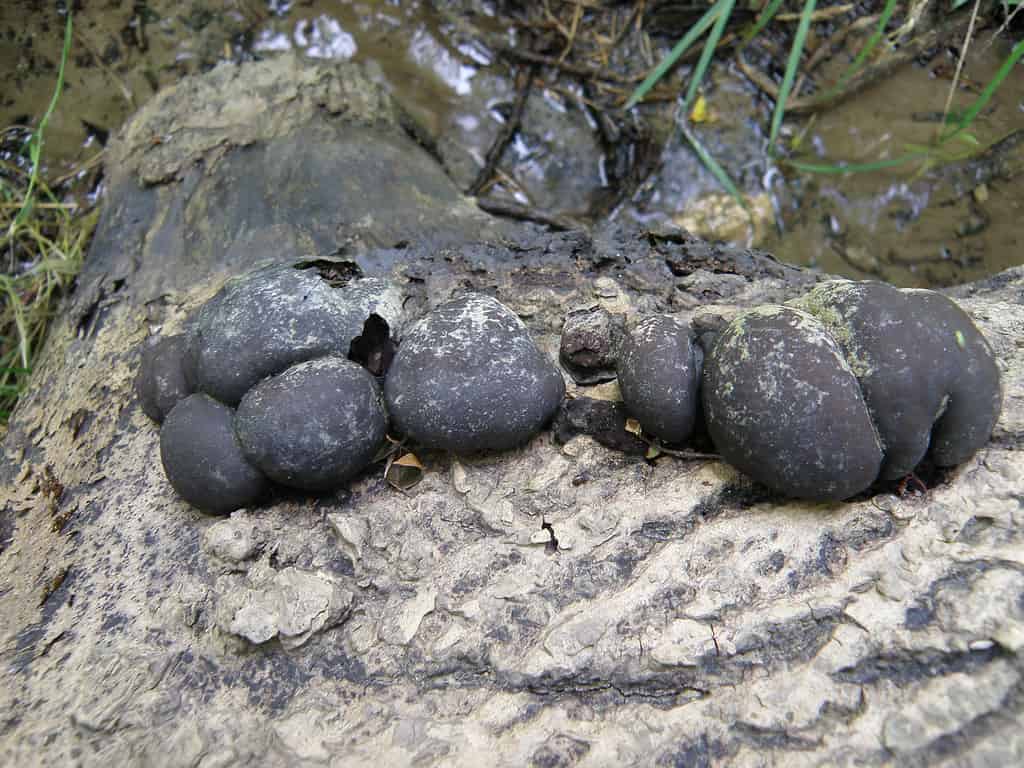
King Alfred’s Cakes, also called Cramp Balls, are small, dark brown, and dome-shaped mushrooms that grow on dead or decaying wood, particularly on hardwood trees like ash, beech, and oak. You can commonly find them in Europe, North America, and Asia. These fungi resemble charcoal briquettes or burnt spheres. You can typically observe King Alfred’s Cakes year-round. People accept them as non-poisonous, but people do not commonly consume them due to their bitter taste. This fungus gets its name from a legend in which King Alfred the Great of England is said to have allowed some cakes to burn while distracted by military matters, resembling these mushrooms to the burnt cakes.
Jelly Ear (Auricularia auricula-judae)
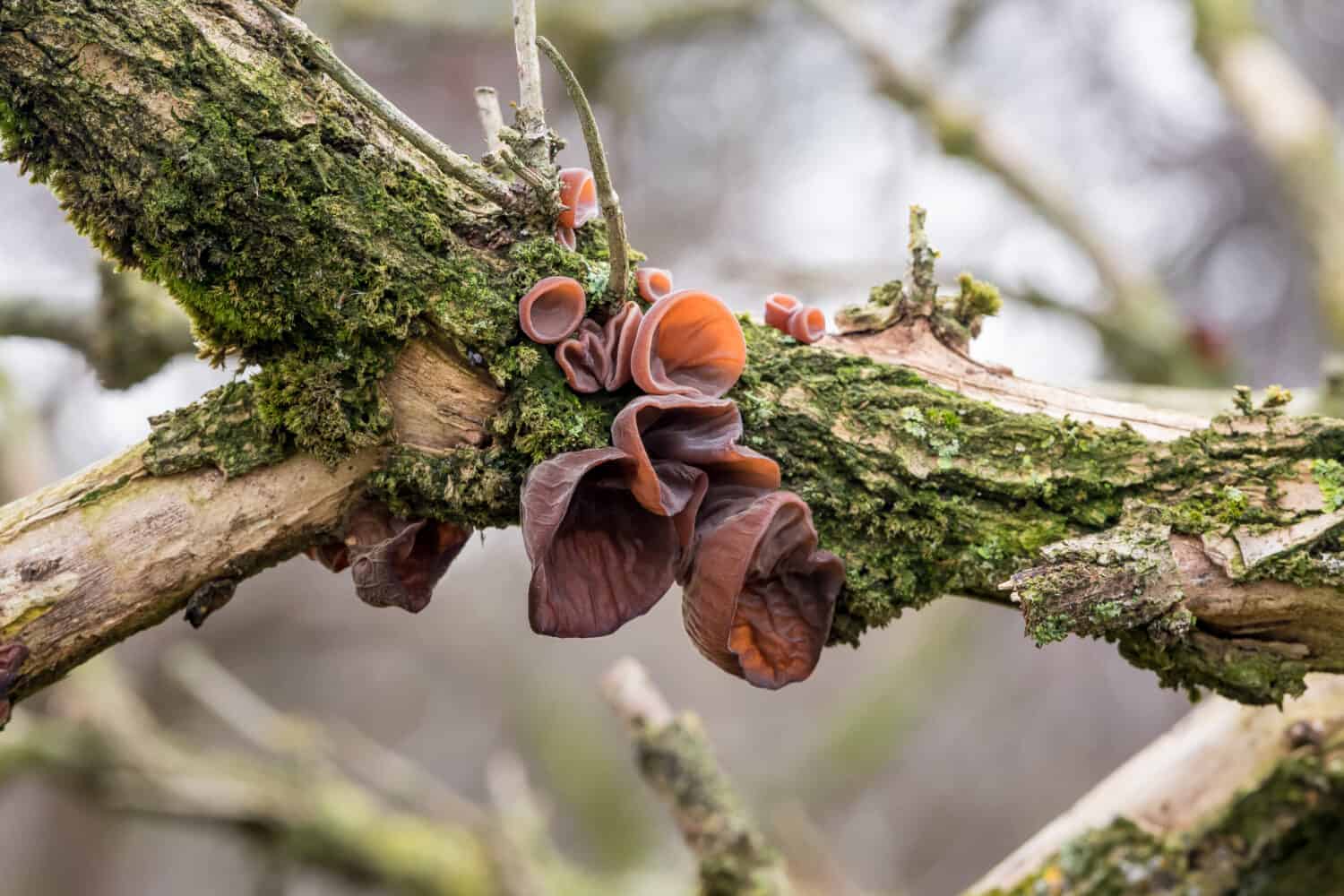
Jelly Ear mushrooms are common in Asian cuisine.
©Jolanda Aalbers/Shutterstock.com
Also known as Wood Ear, Jelly Ear is a jelly-like mushroom that grows on trees. It grows on the deadwood of various deciduous trees, such as elder, beech, and willow. You can find it in temperate regions worldwide. This mushroom has a distinctive ear-shaped or cup-shaped appearance, often with a dark brown to black color. You can most commonly observe Jelly Ear mushrooms in late summer and autumn. They are edible and widely used in Asian cuisine, particularly soups, stir-fries, and salads. The texture is gelatinous when cooked. People have used Jelly Ear mushrooms in traditional Chinese medicine for their potential medicinal properties, such as promoting cardiovascular health and supporting the immune system.
Conclusion
To conclude, these mushrooms that grow on trees showcase the diverse array of fungi that inhabit forests and woodlands around the world. Each mushroom has its unique characteristics, growing on specific types of trees and in particular regions. At the same time, people know some for their culinary value and potential health benefits. Exercising caution and correctly identifying them before consumption is crucial. Even edible mushrooms may cause gastrointestinal distress in some individuals. Each mushroom offers various ecological roles, such as decomposing dead wood and recycling nutrients. These fascinating organisms contribute to the intricate web of life in forests, showcasing the wonder and importance of the fungus kingdom.
The photo featured at the top of this post is © Photoongraphy/Shutterstock.com
The information presented on or through the Website is made available solely for general informational purposes. We do not warrant the accuracy, completeness, or usefulness of this information. Any reliance you place on such information is strictly at your own risk. We disclaim all liability and responsibility arising from any reliance placed on such materials by you or any other visitor to the Website, or by anyone who may be informed of any of its contents. None of the statements or claims on the Website should be taken as medical advice, health advice, or as confirmation that a plant, fungus, or other item is safe for consumption or will provide any health benefits. Anyone considering the health benefits of particular plant, fungus, or other item should first consult with a doctor or other medical professional. The statements made within this Website have not been evaluated by the Food and Drug Administration. These statements are not intended to diagnose, treat, cure or prevent any disease.
Thank you for reading! Have some feedback for us? Contact the AZ Animals editorial team.







